
La Crosse's Struggle for Safe Water
(written by Anita Taylor Doering, Archives Staff)
The city’s first waterworks was designed mainly for fire protection. Fifteen cisterns were built under downtown city sidewalks just for this purpose. Most homes either gathered rainwater or had their own well for domestic purposes, while large industries usually operated several pumps.
In 1876, the La Crosse Lumber Company installed a private waterworks, pump, hydrants, and fire department for use by the mill. The Common Council decided to follow the example set by the city of Winona, Minnesota, and build a system of water mains in 1877. This initial system ran iron pipes from Zeisler’s Brewery to Badger St., Badger to State, Pearl to Division, Division to Mississippi, Front to Fifth, Fifth to Eighth, Eighth to Eleventh, and on Sixth, Eighth and Tenth streets.
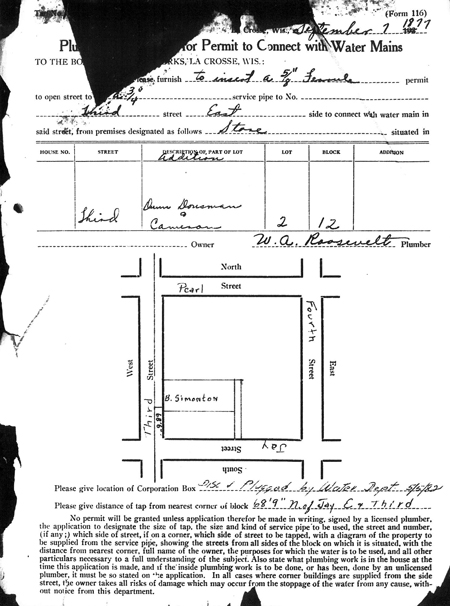
The first water tap to what would become La Crosse's Municipal Water Utility was filled out by plumber William A. Roosevelt for Benton Simonton who owned and operated a flour and feed store on Third Street between Pearl and Jay streets. Records of the Water & Waste Water Utility, La Crosse Series 015, held by the La Crosse Public Library Archives.
The city paid the La Crosse Lumber Company to supply and operate the pumps to fill the system of water mains. This was the beginning of the water utility. The first customer was hooked up to the city water system in September 1877 by plumber William A. Roosevelt to supply water to a flour and feed store at 217-221 Third Street South between Pearl and Jay streets owned and operated by Benton Simonton.
In 1878, the Council bought a pump for the Davidson Mill on the North Side to have them supply water for fire protection to that part of town. A filtered intake pipe placed in the Mississippi River was the only source of municipal water until 1913 when the well system began.

A view of the original Pump House building on King Street, home to the La Crosse Water Works, from 1880-1894. Photo courtesy of the UWL Murphy Library Special Collections and Area Research Center.
In 1880 the planning and construction of a municipally owned and operated water works on King Street began. According to a report to the Council by James Manchester, Superintendent of the Water Works, the total cost of operation and construction was $81,257.11, and 273 taps were made by May 1881. The average amount of water pumped per day was 353,180 gallons. These wells were connected to the intake pipe in the river. Almost every new home in La Crosse built after 1885 tapped into the water main that ran under the street in front of their residence.
The sanitation and quality of the water was constantly under public scrutiny. In September 1894, a special Council committee suggested that a hydraulic engineer would be required to "find ways and means whereby an abundant and permanent supply of healthful water can be guaranteed." Mayor F. A. Copeland experimented by driving wells near Myrick Park during his administration 1891-1893. He was a strong supporter of the well system. The city waterworks building, or the Pump House, was added on to in 1895 and was designed in the Romanesque Revival style by civil engineer John A. Cole.
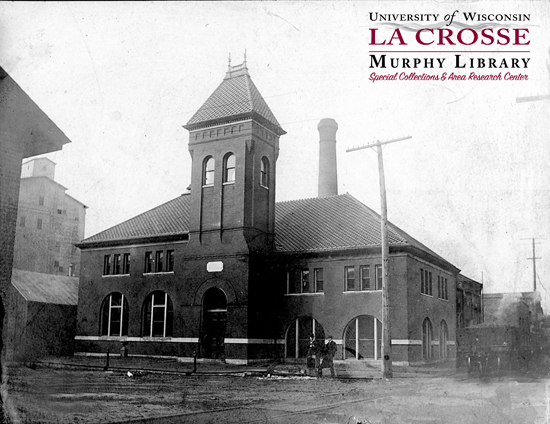
The Pump House gained a second story with a 1895 addition designed by engineer John A. Cole. This building was replaced in 1914 by a new pumping station at Myrick Park. Photo courtesy of the UWL Murphy Library Special Collections and Area Research Center.
Political battles between well system supporters and filtering system advocates were fought on and off until the state railway commission intervened by ordering the city "to establish a sufficient and wholesome supply of water" in 1911. Newspaper clippings describe the bitter discussions that took place until the Oct. 27, 1911, Council meeting at which the well system was finally authorized.
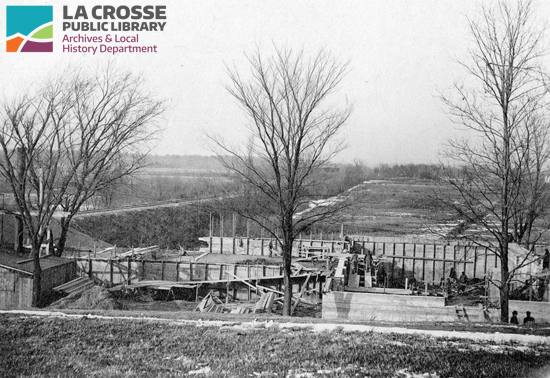
The Myrick Park Pumping Station under construction, looking northwest over the marsh. The Green Bay & Western Railroad tracks through the marsh are visible on the left of the photograph. From the papers of Milburn Gilbertson, MSS 098 held by the La Crosse Public Library Archives.
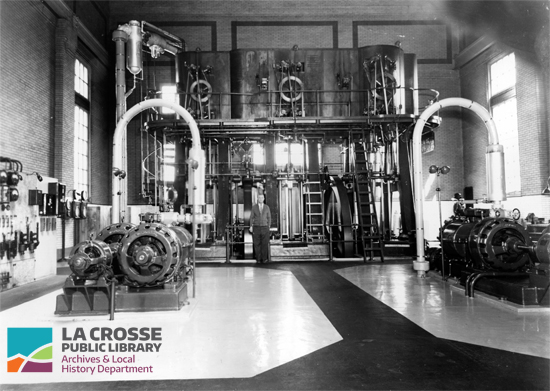
The interior of the then-new Myrick Park Pumping Station, circa 1914, complete with the Holley pump from the papers of Milburn Gilbertson, MSS 098 held by the La Crosse Public Library Archives.
The original pump house was abandoned and repurposed for other city uses while a new water plant near Myrick Park began operations on Dec. 18, 1913, pumping well water through the pipes. The building cost $53,128. Steam boilers, fueled by coal, kept the pumps in operation. Reservoirs were constructed at a cost of $90,952. The reservoirs built then are still in use -- the high reservoir is located on Grandad Bluff and the low one at Myrick Park. In 1914 the five wells, which averaged a depth of 120 feet, were capable of producing 15,000,000 gallons of water per day. The capacity of each well pump was not less than 1400 gallons per minute.
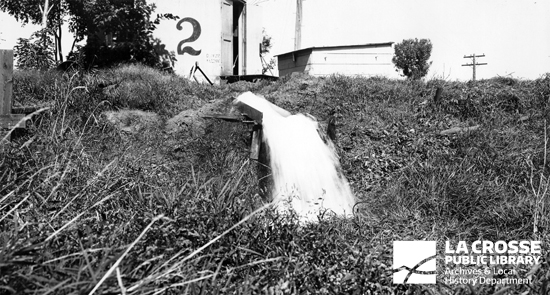
Well number 2 in the La Crosse River marsh showing water flow, circa 1928 from the papers of Milburn Gilbertson, MSS 098 held by the La Crosse Public Library Archives.
By 1928, 20 wells sunk into the marsh supplied water to residents and industries in La Crosse. The water was not chemically treated, and 82.8 miles of water mains existed. All water consumption was metered by this time.
The next big controversy affecting the water supply was the question of chlorination. A state health report ordered the city to begin chloride treatment in 1938, but it wasn't until 1949-1950 that something was done about it. Chlorination was urged by city health officer Dr. Garland Weidner. The U.S. Public Health Service condemned La Crosse water for use in interstate commerce. Reluctantly, the city began to use chlorination as a "standby" measure. By mid-1950, chlorination equipment was permanently in place and used to treat the wells and water supply. Of course today municipal water systems must conform to strict Safe Drinking Water Standards, and constant monitoring and testing are required.
Some of the 27 wells in the marsh were abandoned at this time because of high iron content. A north side well was constructed in 1942 at Sill and George St. Other wells followed south of the marsh.
The wells in the marsh were eventually all abandoned and capped. Today the dike system that connected the wells and to the former Green Bay & Western Railroad has become a popular non-vehicular trail system throughout the marsh. Electrification of the pumping equipment finally came in 1961.
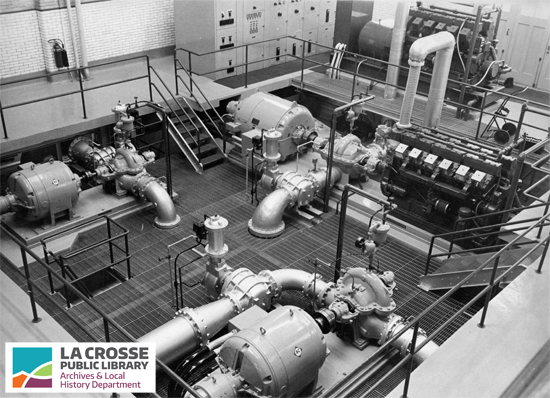
An aerial view of the Allis-Chalmers pumping equipment after the switch to electrification at the Myrick Park Pumping Station, 1961, from the papers of Milburn Gilbertson, MSS 098 held by the La Crosse Public Library Archives.

The control panel of the newly electrified city pumping station at Myrick Park, 1961 from the papers of Milburn Gilbertson, MSS 098 held by the La Crosse Public Library Archives.
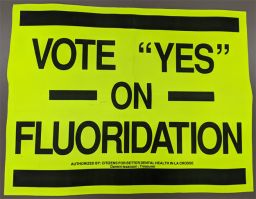
A yard sign from the records of the local group Citizens for Better Dental Health which are held by the La Crosse Public Library Archives.
Advocates for adding fluoride to the water supply to help fight tooth decay began urging this as early as 1946, but the fight continued until 1988 when residents voted to add fluoride to the water. Many previous attempts had failed.
The present water system consists of 15 high-pressure wells located throughout the city, all approximately 100' to 150' deep, that draw water from the sand and gravel aquifer approximately 170 deep in the La Crosse area. Over 220 miles of watermain supply customers. A five million gallon reservoir is used to maintain system pressure and to store water for periods of high demand and fire protection.
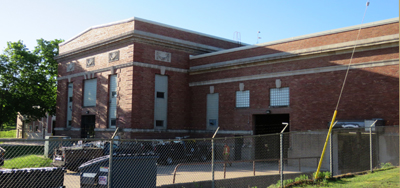
The Myrick Pumping Station today has been added on to many times and other buildings also constructed on the site serve the Water Utility's needs.
In the news today is the concern of the contamination of private wells on French Island (Town of Campbell). In May 2019, the city detected minute quanities of PFAS in two municipal wells and groundwater samples near the La Crosse Regional Airport. The DNR has labeled the city of La Crosse as the responsible party. These hazardous polyfluoroalkyl substances are human-made chemicals that are known to cause health concerns over time if ingested. At this time it is thought that the ground water was exposed to PFAS through fluorine based Class B foams for firefighting use at the municipal airport. This investigation and testing is ongoing at this time, in addition to constant monitoring.
